As energy costs continue to rise, there’s never been a better time to consider the benefits of installing flat-roof solar panels. Harnessing the sun’s power to generate electricity for your home or business is environmentally friendly and can save you money in the long run. Are you ready to learn more about this exciting and cost-effective solution? Let’s dive in!
Key Takeaways
- Flat roof solar panels offer reliable energy production with minimal water damage risk.
- Installing flat roof solar panels can provide significant potential savings and reduced energy bills.
- Professional installation of flat roof solar panels is the best way to ensure efficiency, safety and maximum benefit from your system.
Flat Roof Solar Panels: An Overview
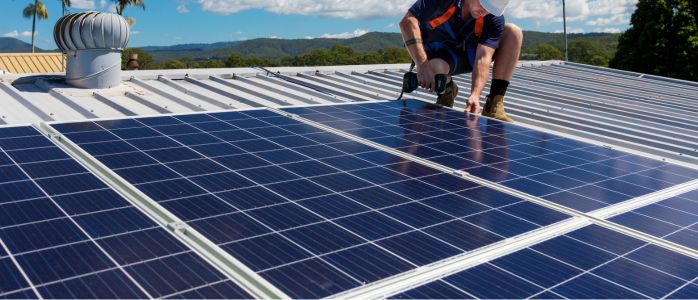
Flat roof solar panels are a specialized form of solar photovoltaic (PV) panels designed to maximize energy efficiency on flat surfaces, making them ideal for installation on flat roofs. These panels are becoming increasingly popular for commercial and domestic properties due to their accessibility and versatility. Flat roof solar panels are less prone to water damage than other types of solar panels, making them an attractive option for flat roof installations.
Installing solar panel systems on flat rooftops is a practical choice. PV panels installed on a flat surface can maximize the sunlight each panel receives, which is optimal for energy production. Having an expert check the roof before installing solar panels can help ensure that the roof can reliably support the solar panel’s load, thus providing a great advantage.
Types of Flat Roof Solar Panels
Flat roof solar panels are specialized PV modules that provide an incredible energy solution for flat surfaces, such as commercial and domestic properties. They can be installed on various roofing materials, like Torch Down Roof, Foam, and Wood, which are all excellent options for flat roofs when installing solar panels.
Commercial and domestic properties alike can benefit from flat-roof solar systems. They can easily be installed on all types of buildings, including those with flat roof systems.
How Flat Roof Solar Panels Work
Flat roof solar panels require specific mounting systems to ensure optimal sunlight exposure and energy production for a flat roof solar system. One of the popular mounting options for flat roof solar panels is the tub and ballast system, which can be considered as a flat roof system, where the panels are securely mounted onto a tub and secured with ballast (gravel, paving slabs, bricks, rocks, etc.) to ensure stability in high winds. Alternatively, the panels can be mounted onto metal frames for a secure fit, providing proper installation.
The ideal pitch for a solar panel on a flat roof is around 30 degrees off the horizontal, which is an excellent angle for maximum efficiency. The two methods of mounting flat roof solar panels offer different advantages, such as the ability to fix the panels to the structure of the flat roof or to place heavy slabs along the roof and place ballast frames on top of the slabs. This allows for a flexible approach, depending on the building structure and location.
Mounting Systems for Flat Roof Solar Panels
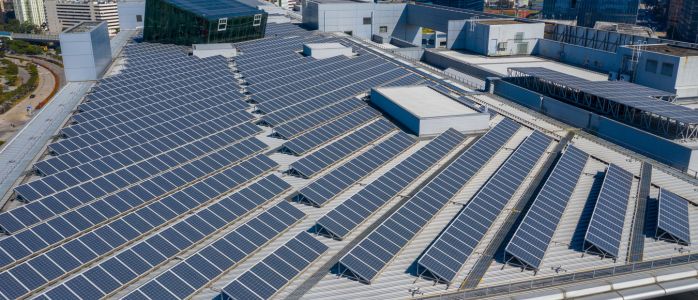
The stability and efficiency of the solar panel installation hinge on the mounting systems used for flat-roof solar panels. Two main mounting systems for flat roof solar panels are fixed mounting equipment and weighted tub/bucket systems. These mounting systems provide great versatility and help to optimally position the panels to capture the sun’s rays and generate electricity.
The choice of mounting system depends on the roof’s specific requirements and the property owner’s preferences. Both fixed mounting equipment and weighted tub/bucket systems have their advantages and can be tailored to suit the needs of the installation.
Fixed Mounting Equipment
Fixed mounting equipment efficiently and securely attaches solar panels to the roof structure, providing stability and optimal positioning for maximum efficiency in a solar panel array once the solar panels are installed.
There are several exciting types of fixed mounting equipment available for solar panels, including:
- On-roof systems
- RCC Roof Mounts
- Ground mounts
- Solar carports
- Shed mounts
- Tracking structures
Fixed mounting equipment offers a reliable and sturdy mounting system for solar panels, enabling them to be set up at the ideal angle for maximum efficiency. With mount panels, you can ensure a secure and lasting installation.
Weighted Tub/Bucket Systems
Weighted tub/bucket systems provide a secure way to mount solar panels without damaging the roof, ensuring its strength and integrity. These systems use heavy ballast materials like gravel or paving slabs to hold the solar panels in place.
The types of weighted tub/bucket systems include:
- Flexible buckets
- Mixing tubs
- Standard weight tubs
- Heavy-duty buckets
Weighted tub/bucket systems offer a flexible approach to mounting solar panels on a flat roof, allowing for easy installation and minimal impact on the roof structure.
Optimal Angle and Direction for Flat Roof Solar Panels
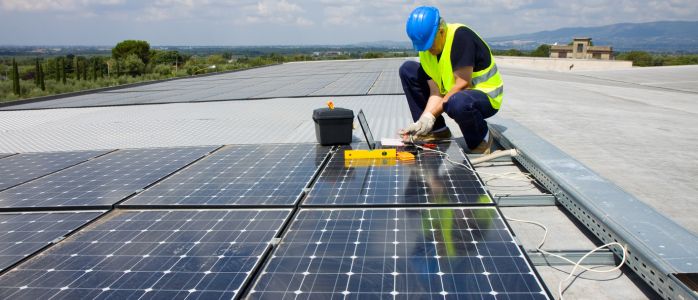
Maximizing the efficiency of the solar panel system is mainly reliant on the optimal angle and direction of flat roof solar panels. The best angle for flat roof solar panels is usually between 30 and 45 degrees, while the best direction is typically south-facing.
Ensuring the correct angle and direction for your flat roof solar panels will maximize sunlight absorption and energy production, providing you with the most benefits from your solar panel system.
Ideal Angle for UK Solar Panels
The optimal angle for solar panels in the UK is between 35-40 degrees. This angle allows for maximum absorption of sunlight and energy production.
By positioning the solar panels at an angle between 20-50 degrees, you can maximize sunlight absorption and energy production, providing a great benefit for UK residents looking to harness the power of solar energy.
Proper Installation by Professionals
Guaranteeing the correct angle and direction of your flat roof solar panels, qualified professionals can maximize efficiency and prevent damage through proper installation. Professionals bring their experience and expertise to ensure that the installation is done correctly and safely, providing valuable advice on the best type of system for a particular roof and the most efficient way to install it.
Hiring solar panel installers to set up your flat roof solar panels will guarantee that the installation process is done efficiently, safely, and by your roof’s specific requirements.
Costs and Savings Associated with Flat Roof Solar Panels
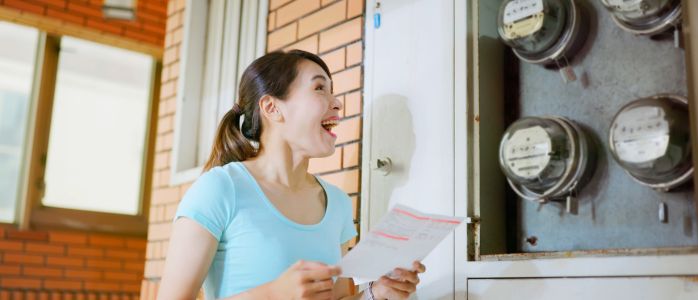
Affordability is a crucial feature of installing solar panels on a flat roof in the UK, ranging from £750-£900 per kW for commercial premises and around £825 per kW for residential installations. Although the installation costs may be higher than those for pitched roofs due to additional materials and structural engineering requirements, the potential savings from flat-roof solar panels can be significant.
Flat roof solar panels offer a range of exciting potential savings, such as reduced energy bills and government feed-in tariffs, with a possible profit of £6,100 after 25 years. By harnessing the solar energy generated by the flat roof solar panels to power your home, rather than relying on energy from the grid, you can lower your energy bills and contribute to a greener future.
Installation Costs
The installation costs of flat roof solar panels can vary depending on the type of flat roof you have and the installation’s specific requirements. Additional materials required for flat roof solar panels include:
- Mounting rails
- Flashing
- Sealants
- Structural engineering requirements, such as reinforcement of the roof structure ensure a successful installation.
Despite these additional costs, flat roof solar panels provide a cost-effective and environmentally friendly solution for harnessing solar energy.
Potential Savings
Flat-roof solar panel systems can substantially save over time by reducing energy bills and contributing to government feed-in tariffs. A 4 kWp solar PV system can save up to £230 a year. On average, the annual savings are around £80-£230.
An average three-bedroom house can benefit significantly from installing a 3.5 kWp solar PV system. The potential savings can be as high as £557 per year. With the increased adoption of solar panels, the potential savings and benefits are becoming more widely recognized, making flat-roof solar panels an attractive investment for those looking to save money and reduce their carbon footprint.
Planning Permission and Warranty Considerations

Considering any planning permission requirements and the impact on your roof’s warranty is vital when installing flat roof solar panels. In most cases, flat roof solar panels are covered under permitted developments and do not require planning permission. Still, it’s always best to check with your local planning authority for any specific requirements.
Additionally, installing flat roof solar panels generally does not affect the roof warranty, as long as they are installed properly and by the manufacturer’s instructions.
Planning Permission for Flat Roof Solar Panels
Generally, you won’t need planning permission for flat roof solar panels as long as your installation follows the guidelines provided by your local council. However, there may be exceptions to this rule, such as in conservation areas or listed buildings.
To confirm if you need planning permission for your flat roof solar panel installation, it’s best to consult your area’s Local Planning Authority.
Warranty Implications
Although installing flat roof solar panels typically does not affect the roof warranty, it’s important to contact the roof warranty provider before installing the panels to ensure that the warranty will remain valid.
Proper installation and adherence to the manufacturer’s instructions can help preserve your roof’s warranty while taking advantage of the benefits of solar energy.
Weather Conditions and Maintenance
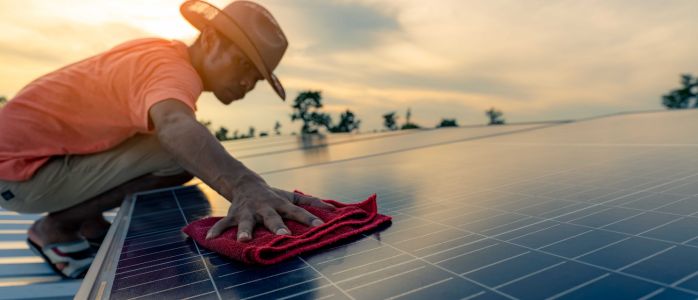
Although weather conditions like rain and wind can impact flat-roof solar panels, these risks can be mitigated through proper mounting systems and installation. Rain can help wash away dirt and debris that may accumulate on the panels, enhancing their performance, while high winds can help secure the panels, providing additional stability.
The optimal performance of your flat roof solar panels necessitates regular cleaning and maintenance. Self-cleaning panels and correct positioning can reduce dirt accumulation, while periodic inspection and cleaning can help maintain the efficiency of your solar panel system.
Rain and Wind Impact
Rain and wind can damage flat roof solar panels, but proper mounting systems and installation can mitigate these risks. Ensuring the panels are securely fixed to the roof can help protect against wind forces. At the same time, rain can act as a natural cleaning agent, washing away dirt and debris to help maintain the panels’ efficiency.
Taking appropriate precautions can minimise the impact of rain and wind on your flat roof solar panels.
Cleaning and Maintenance
Flat roof solar panels require regular cleaning to ensure optimal performance. Here are some tips for cleaning your solar panels:
- Clean the panels at least once a year using a soft brush or squeegee.
- Mount the panels at an angle of at least 10 degrees to allow for self-cleaning with rainwater.
- Regular cleaning prevents dirt build-up and helps the panels perform at their best.
Proper cleaning and maintenance will help to prolong the life of your solar panel system, allowing you to enjoy the benefits of renewable energy for years to come.
Solar Thermal Systems for Flat Roofs
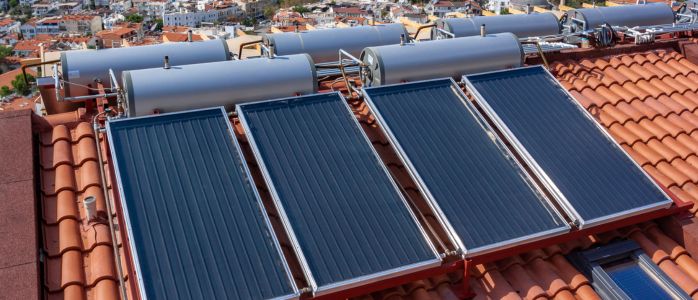
As an alternative solution for flat roofs, solar thermal systems provide renewable heating during colder months and contribute to reduced energy bills and carbon emissions. These systems harness the sun’s energy to heat water stored in a hot water tank for future use, offering a cost-effective and environmentally friendly heating solution.
Benefits of Solar Thermal Systems
Solar thermal systems can be installed on flat roofs to provide renewable heating during colder months, reducing energy bills and carbon emissions. Investing in solar thermal systems can save even more money on your energy bills while contributing to a greener future.
Solar thermal systems offer a range of benefits, including hot water for domestic use, lower energy bills, and decreased carbon emissions, making them a great alternative to traditional heating methods.
Mounting Racks for Solar Thermal Systems
Mounting racks install solar thermal systems on flat roofs, ensuring the correct angle and positioning for maximum efficiency. These racks include:
- Roof hooks
- Mounting frames
- Ground mounting structures
- Adjustable angle mounting frames
These components provide a secure attachment of the solar thermal panels to the flat roof.
Proper installation of mounting racks for solar thermal systems is crucial for achieving maximum efficiency as it allows the solar thermal system to capture the most sunlight available.
Summary
In conclusion, installing flat roof solar panels is a fantastic way to harness the power of the sun to generate electricity for your home or business. With proper installation, mounting systems, and angle positioning, you can maximize the efficiency of your solar panel system while reducing your energy bills and carbon footprint. Exploring alternative solutions, such as solar thermal systems, can also provide renewable heating options for your property. By investing in solar energy, you are not only saving money but also contributing to a greener, more sustainable future for our planet.
Frequently Asked Questions
Is it worth putting solar panels on a flat roof?
Installing solar panels on a flat roof is a great option, as it offers several advantages, such as using less material, quick installation, and the ability to adjust the panel’s angle to receive optimum sunlight. Additionally, you will benefit from green, clean, renewable energy while reducing your electricity bills.
What is the lowest roof pitch for solar panels?
The best roof pitch for solar panels is 30-50° to catch the maximum sunlight and generate the most solar energy possible. Pitches outside of this range can still generate electricity effectively; however, they won’t be as efficient. The roof’s angle will also determine how the solar panels are attached.
How many solar panels does it take to power a flat?
It’s estimated that the average one-bedroom house requires six solar panels, while a typical three-bedroom house needs ten panels to power it. So, generally speaking, it takes about six to ten solar panels to power a flat.
Do I need planning permission for solar panels on a flat roof?
You will likely need planning permission to install solar panels on a flat roof, as they are usually placed in frames to create an angle towards the sun. This is because the frames need to be securely attached to the roof, and the angle of the panels needs to be adjusted to get the most out of the sun’s energy.
What is the ideal angle for flat roof solar panels in the UK?
For optimal performance, flat roof solar panels in the UK should be angled between 35-40 degrees; this allows for maximum absorption of sunlight and energy production. Angling the panels correctly is essential for achieving the best results. The angle should be adjusted depending on the season and the location of the solar panel. In the summer, the angle should be slightly higher, while in the winter it should be
